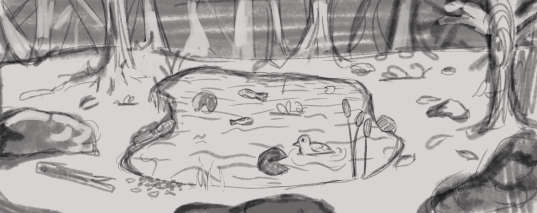How to draw a pond
A pond is a beautiful element in nature, making it a great subject for drawing. Whether you’re a beginner or an experienced artist, this guide will walk you through the process of sketching and shading a realistic pond scene. This can be used with graphite, charcoal, or digital. When you start to draw, think of the overall scene. (what season? Is it in a forest, or grasslands? Are there trees?)
Step 1: Sketch the Outline
Start by lightly drawing the shape of the pond. Ponds usually have irregular, natural edges, so avoid making it too symmetrical, if you do this it can look artificial and simple. Use a pencil to outline the water body and any land around it. I used “s” shapes for the sides of my pond. I kept the top and bottom straight for simplicity, and I added in the ground. I narrowed the top of my pond and widened the bottom to give the illusion that the furthest point away is the top.
Step 2: Add Depth with Water Effects
Water can be tricky to depict. Use curved lines to show ripples on the surface. Light shading near the edges can help create the illusion of depth, if you’re going for simplicity I would ship the shading, because if you’re going for a more coloring book effect it’s hard to do that with shading. To make the water look more realistic, I would look at pictures of water reflections to replicate. Ill give you examples.
Step 3: Incorporate Surrounding Elements
To make your pond look more realistic, add surrounding details such as grass, rocks, and reeds. I added lily pads, rocks around the edge, trees surrounding, dead leaves and branches, grass and bushes. As I’m doing this, I’m keeping in mind that I want my scene to be placed in fall. Draw different shapes and textures to give a natural look. keep in mind that usually the background is less detailed than the foreground to bring attention to the foreground. Sometimes the background is lighter or darker than the general piece, usually not the same value.
Step 4: Include Wildlife
A pond is never complete without some wildlife! You can add frogs, ducks, fish, or even dragonflies to make your drawing more lively, and make it feel like an actual pond. I added ducks, dragonflies and fish.
Step 5: Use Shading and Textures
Shading helps add realism. Darken areas under rocks, deepen shadows in the water, and add texture to the plants.. If you want a nice simple pond, I would skip this step altogether. I would think about light and shadows on this step.
Final Touches
Review your drawing and refine any details. Add reflections or highlights on the water to make it look more natural. Once satisfied, you can ink the outlines or use color for a vibrant finish, and give it some life. I decided to stick with a pencil, sketchy-like finish, grayscale.
Conclusion
Drawing a pond is a rewarding experience that helps improve your understanding of nature and composition. With practice, you can create stunning pond scenes filled with life and detail. Have fun!

